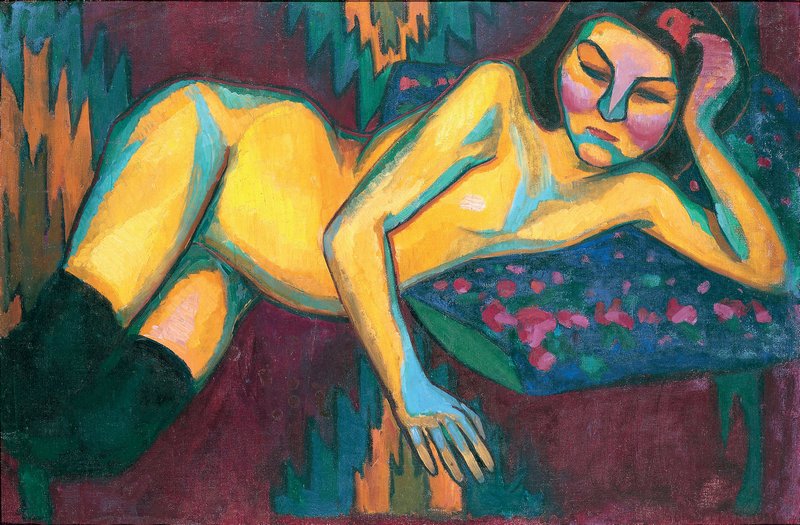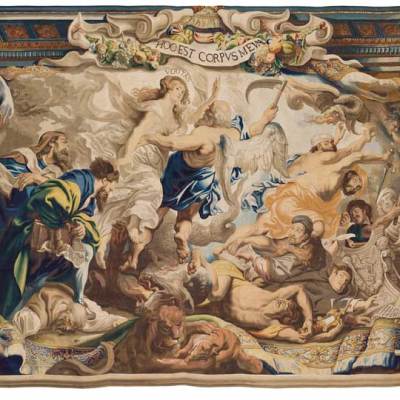This article was first published in the print edition of The Spectator magazine (18 April 2015), and on The Spectator’s Culture House blog
In 1978, shortly before she died, the artist Sonia Delaunay was asked in an interview whether she considered herself a feminist. ‘No! I despise the word!’ she replied. ‘I never thought of myself as a woman in any conscious way. I’m an artist.’
It is pretty obvious, though, that the Sonia Delaunay retrospective at Tate Modern (which has come from the Musée d’Art Moderne de la Ville de Paris) has been organised if not explicitly by feminists, then at least with feminism in mind. You can see the thinking behind it: let’s give the wives of the artists a break. And Mrs Delaunay, whose work has traditionally been discussed in the same breath as her artist husband Robert’s, must have seemed a suitable candidate for some revisionism.
So Robert has been stripped out as much as possible, to give Sonia a chance to emerge from the shadows. Yet she was never really in them. The show begins with her arrival in Paris in 1906, when she was introduced to the work of the impressionists, post-impressionists and fauves. In her early portraits (a number of which are terrific, Portrait de Tchouiko in particular) she takes stock of contemporary developments and is brazen with her quotations: rich colour from Matisse, blue hues from Picasso, the exotic — and the erotic — from Gauguin. Her short-lived marriage to the gay art collector Wilhelm Uhde may well have been platonic, but it provided fertile soil for Sonia’s career. Through Uhde, she took part in an exhibition that featured work by Braque, Picasso, Derain and Dufy. He also introduced her to Robert Delaunay. Two years later, she divorced Uhde, married Delaunay and her days as a beard were over.
There are a number of points in the show where the attempt to sideline Robert feels unnatural. As a couple, they developed a new theory of colour contrasts, which they referred to as ‘simultanism’. Based on the theories of M.E. Chevreul, this lyrical abstraction later became known as orphism. In her early experiments, Sonia veers in and out of abstraction; amid the circular shapes are dancing figures, buildings and words. She is reacting to cubism, but at the same time refusing to adopt its drab palette of colours. Paintings such as Le Bal Bullier and Magic City are exploratory and yet, without her husband’s work to compare them to, it feels as if something is missing. ‘As they wake up, the Delaunays speak painting,’ said the critic Guillaume Apollinaire. Without Robert’s presence, the conversation appears one-sided.
Even if we can’t see the artistic dialogue, it’s not hard to imagine the more familial ones. Following the Bolshevik revolution of 1917, funding from Sonia’s St Petersburg family was cut. With her own family to feed, her pragmatism exerts itself. In 1918, she opened Casa Sonia, a fashion and design shop in Madrid that sold accessories, furnishings and fabrics based on the theories she had devised with her husband. As she later put it, ‘he talked, but I realised’.
At the hub of this exhibition are Sonia Delaunay’s textiles, produced in her Atelier Simultané in Paris. They seem astonishingly modern and are a genuine joy to discover. These radical designs move far beyond the geometric circles seen in her earlier work. Again, she takes her cue from key members of the avant-garde: there is a coat decorated as if by Matisse, and a harlequin jacket that looks like a cast-off from a Picasso painting. This is no criticism; if anything, it is testament to Sonia Delaunay’s commercial intelligence. She saw an early opportunity to capitalise on this artistic period and, in doing so, added her own contributions.
During the Great Depression, Sonia Delaunay shut down the business, although her fabric designs were available for many years in department stores like Metz & Co and Liberty. In 1937, the Delaunays were invited to take part in the International Exhibition of Arts and Technology in Modern Life. Sonia painted three large murals — Motor, Dashboard and Propeller — for the Palais de l’Air. They depict the inner workings of an aeroplane set against rainbow-coloured circles. When the show opened, the French prime minister, Léon Blum, declared it a ‘triumph of the working class, the Popular Front and liberty’. His words now sound somewhat absurd: the show is best remembered for a symbolic standoff between the pavilions presented by Nazi Germany and Stalinist Russia, while over in the Spanish pavilion, Picasso exhibited ‘Guernica’ for the first time.
In 1941, Robert Delaunay succumbed to cancer and Sonia lost her artistic soulmate. The final rooms of this show feel both reflective and melancholic, as she reverts back to the circular works produced before her textiles. Hoping to keep Robert’s legacy alive, she tried to stay true to his theories. Perhaps she found solace in the chromatic abstraction they both pioneered, yet I wonder what might have been had she been less loyal, less devoted and more interested in exploring on canvas the diverse abstract design seen in her textiles.
I have not managed to strip out Robert, and neither, really, have the curators. Contemporary discourse may prefer to view Sonia sans Robert, wife sans husband, and she is certainly just as good, if not better, than he. But they broke boundaries together, as a married couple, as a family, sometimes out of necessity, sometimes out of something more nebulous. Sonia Delaunay is certainly worthy of a retrospective in her own right, but her story is one of a man and woman working in harmony as artists, simultaneously, rather than the opposite.
This article first appeared in the print edition of The Spectator magazine, dated 18 April 2015. For more arts coverage from The Spectator follow the Culture House daily blog.
‘The EY Exhibition: Sonia Delaunay’ is at Tate Modern, London, until 9 August.







